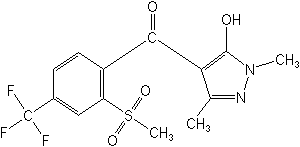|
Activity: Herbicide
(phenyl pyrazolyl ketone)
CAS Name: (5-hydroxy-1,3-dimethyl-1H-pyrazol-4-yl)[2-(methylsulfonyl)-4-(trifluoromethyl)phenyl]methanone
Structure:

Regulatory
Information
(only comprehensive for the US) |
| US
EPA Registered: |
Pending |
| Other
Information |
| Molecular
Formula: |
C14H13F3N2O4S |
| Manufacturer: |
Bayer
CropScience |
| Other
Name(s): |
AE
0317309 |
| Of special interest: |
April
2005 - Initial
submission from Bayer to USEPA. One-generation reproduction
study in wistar rats (pilot study for a two-generation reproduction
study with administration in the diet):
The
purpose of this one-generation study was to evaluate possible
effects of AE 0317309 on the parental generation and the
entire reproduction process in Wistar rats. This study was
intended as a pilot study for a subsequent two-generation
study. AE 0317309 was administered to groups of 10 male
and 10 female rats at concentrations of 0 (control), 100,
600 or 3600 ppm in their diet. Survival, appearance and
behavior of F0 rats were not affected up to
3600 ppm. The male F0 rat body weight depression
was evident from 600 ppm onwards. In F0 females
the body weight gain was decreased at some time points of
gestation and lactation at 3600 ppm. At 3600 ppm F0
rats exhibited an increase in food intake per kg body weight.
At necropsy parental rats showed no macroscopic treatment-related
findings up to 3600 ppm. There was a non-dose related increased
absolute and relative weights of the testes and epididymides
in all treatment groups are not considered to reflect a
toxic effect. From 600 ppm o nwards increased relative
liver and kidney weights were calculated in males. The indices
of insemination, fertility, gestation, rearing and life
birthis as well as mating performance, duration of pregnancy,
birth weights, number of pups born, percentages of males
born and prenatal loss were not affected at levels of up
to 3600 ppm. At 3600 ppm the number of implantation sites
and the mean litter size were reduced. The pup weights were
retarded from post-natal day 21 onwards.
There
were no treatment related changes in viability or lactation
indice at any dose level. Clinical observation of F1
pups revelealed no remarkable changes up to 3600 ppm. At
3600 ppm pups exhibited a slight incidence of renal pelvic
dilation (6/94 vs 0/97 in controls). There was a tendency
for reduced absolute and relative spleen weights in male
and female F1 pups from 600 ppm onwards. Thus
the no-effect levels (NOEL) for the parental animals and
pup body weights from post-natal day 21 onwards was 100
ppm. The NOEL for reproduction parameters was 600 ppm.
|
| •
May 2005 - new pesticide |
| US Federal Register |
| Date Published |
Docket Identification
Number |
Details |
| February 7, 2007 |
EPA-HQ-OPP-2006-1026 |
Bayer CropScience
LLC. First-time
petition for new tolerance. PP 6F7059. 27709. Proposal
to establish a tolerance for residues of the herbicide
pyrasulfotole (AE 0317309) (5-hydroxy-1,3-dimethyl-1H-pyrazol-4-yl)[2-
(methylsulfonyl)-4-(trifluoromethyl)phenyl]
methanone and its metabolite (5-hydroxy-3-methyl-1H-pyrazol-4-yl)[2-(methylsulfonyl)-4-(trifluoromethyl)phenyl]methanone
in or on food commodities
-- barley/oat/rye/triticale/wheat, grain at 0.07 ppm;
-- barley/oat/rye/wheat, straw and oat/rye/wheat, forage at
0.25 ppm;
--barley/oat/wheat, hay at 0.8 ppm;
-- wheat, aspirated grain fractions at 1.4 ppm;
and pyrasulfotole (AE 0317309) in or
on
-- cattle/goat/hog/horse/sheep, meat and fat at 0.01 ppm;
-- cattle/goat/hog/horse/sheep, meat byproducts at 0.3 ppm;
-- milk at 0.005 ppm.
|
|